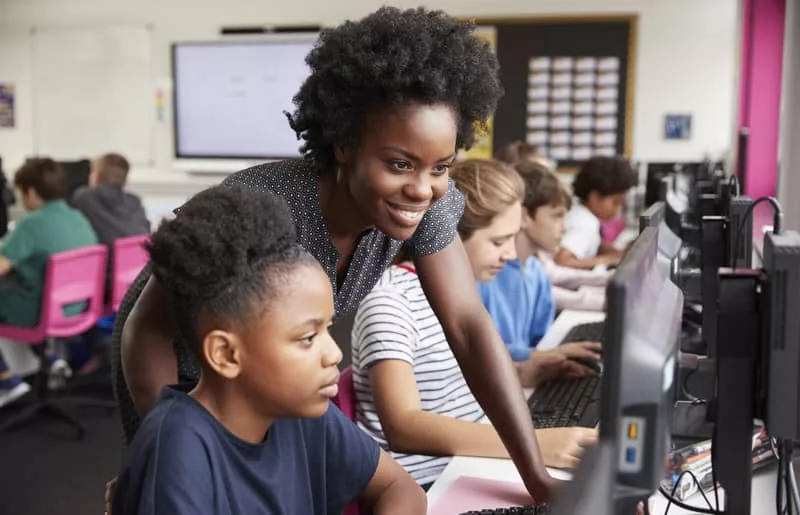Benton Harbor Area Schools leaders working to stem the tide of an increasing teacher shortage will work with Kalamazoo Public Schools and Western Michigan University to develop a talent pipeline to help resolve that shortage thanks to a $5-million grant.
Even before COVID-19, school districts nationwide were battling a teacher shortage. A report by the Economic Policy Institute found that while demand for instructors is increasing at K-12 schools, the number of qualified teachers available is on a sharp decline, and the gap is even more pronounced when certification is taken into account. The new partnership between Western Michigan University, Benton Harbor Area Schools and the Kalamazoo Public Schools will develop a new pipeline to fill the dire need for quality instructors.
Dr. Regena Fails Nelson, chair of WMU’s Department of Teaching, Learning and Educational Studies, secured a $4.9 million U.S. Department of Education grant to spearhead the Urban Teacher Residency Program. The product of nearly two years of planning, that program will pay for candidates within the districts–like paraprofessionals, bus drivers, food service staff and custodians–to earn their teacher certification while they work, mitigating some of the barriers that impede qualified candidates from pursuing a career.
Nelson says, “Our undergraduate model is a typical four-year degree and you’re getting your certification,” adding, “For traditional students who are coming out of high school, it’s a great model. But we recognize that with a teacher shortage, that pipeline will not fill all the openings that we’re going to have for teachers in the next five to 10 years. So, we need to think creatively about people who want to come back to this who are in schools already in some capacity. How can we fast-track them to getting certification?”
Boosting access to certification is more important than ever with the pandemic accelerating teacher retirements in many areas and leading to deep budget cuts as districts work to stay financially afloat.
Sheila Dorsey-Smith, Assistant Superintendent for Human Resources at Kalamazoo Public Schools, says, “It will be a tremendous opportunity not just for WMU, but KPS and Benton Harbor, to train teachers to work in our urban environments,” adding, “We want to lift up our community by lifting up individuals with a heart for children and a passion for teaching to become part of the change we are trying to make in Kalamazoo Public Schools.”
The program will use a teacher residency model that includes a yearlong clinical experience with the required coursework for certification. Residents will receive intensive coaching and feedback in their cohorts as they apply what they’re learning in the classroom to their coursework. The goal is to produce at least 90 certified teachers who will be placed in full-time teaching positions within three years.
The grant also required WMU, KPS and BHAS to provide matching funds to ensure the program is sustainable on its own. If it’s successful, this could serve as a model for school districts across the country.
Dorsey-Smith says, “In other professions, interns or apprentices are paid to solidify their place in their chosen profession. In education, it is quite the opposite; we pay to learn the profession,” and adds, “This program, though grant-funded, may be the way of the future as we look to grow teacher ranks—especially in urban environments.”
The first cohort is expected to begin in July 2021.
In addition to helping districts grow their talent from within, the Urban Teacher Residency Program is also committed to diversifying the classroom by ensuring at least 20-percent of program participants are from racially diverse backgrounds.
Acknowledging that it’s common for many students to progress from kindergarten through 12th grade with just one or two teachers of color, Dorsey-Smith suggests, “It is inherent that young people have the opportunity to be taught by people who look like them. It is a huge self-esteem booster to be taught by someone who knows and understands your culture.” She adds, “In Kalamazoo Public Schools, for example, 38-percent of the student population is African American, compared to only 13-percent of teachers. All students benefit from having teachers of color, not just students of color. Education is richer when diverse backgrounds are represented and respected.”
There’s value to the lived experience that comes with diversity, says Nelson,”It can be harmful to children if the teachers don’t understand what certain behaviors mean, how certain families communicate, what certain families value and why, and how it is all related to valuing education. This cultural knowledge is what we bring as educators of color to the field.”
In her own experience working at Northglade Montessori Magnet School in Kalamazoo years ago, Nelson remembers an interaction with two boys who saw her walking down the hall.
As she tells the story, “One little boy said, ‘You know who she is? She’s the principal of Western Michigan University.’ An African American woman was principal at Northglade, and they looked at me and my role and thought, ‘She must be a principal, too.’ And that just meant a lot to me that they were understanding these leadership roles in our society and who was in the leadership roles.”
Dorsey-Smith concludes, “When young people see (others who look like them or share their culture) in positions of power and authority, it gives them the courage to try to achieve that position. When a child sees mostly minorities in support positions, that too sends a message that maybe they are not enough for the professional position. That is one of the messages we are trying to dispel.”






